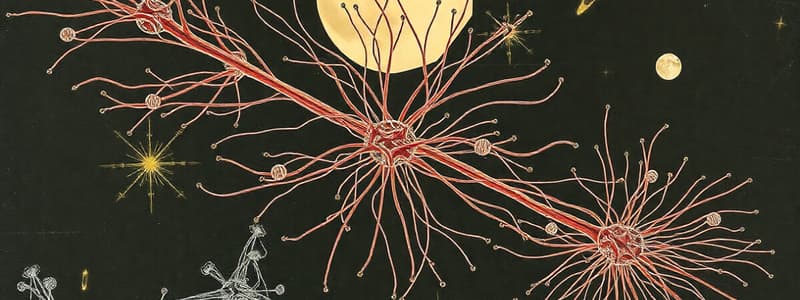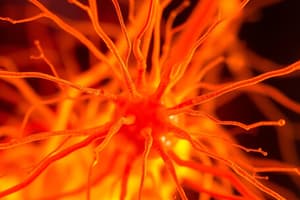Podcast
Questions and Answers
What is the outer diameter of microtubules?
What is the outer diameter of microtubules?
- 50 nm
- 100 nm
- 25 nm (correct)
- 10 nm
Actin filaments are more rigid than microtubules.
Actin filaments are more rigid than microtubules.
False (B)
What is the primary protein that makes up microtubules?
What is the primary protein that makes up microtubules?
tubulin
Intermediate filaments have a diameter of about _____ nm.
Intermediate filaments have a diameter of about _____ nm.
Which structure is known as the microtubule-organizing center?
Which structure is known as the microtubule-organizing center?
Match the following cytoskeletal structures with their characteristics:
Match the following cytoskeletal structures with their characteristics:
The structural rearrangement in a cell requires significant energy when conditions change.
The structural rearrangement in a cell requires significant energy when conditions change.
What type of projections do actin filaments form for exploration and movement?
What type of projections do actin filaments form for exploration and movement?
What is the purpose of adding premade nuclei during polymerization?
What is the purpose of adding premade nuclei during polymerization?
The lag phase corresponds to the time taken for polymer disassembly.
The lag phase corresponds to the time taken for polymer disassembly.
What are the two ends of an actin filament or microtubule called?
What are the two ends of an actin filament or microtubule called?
The ___ phase occurs as monomers add to the exposed ends of the growing filament.
The ___ phase occurs as monomers add to the exposed ends of the growing filament.
Match the phases of polymerization with their descriptions:
Match the phases of polymerization with their descriptions:
Which of the following is true regarding the growth rates of the plus and minus ends?
Which of the following is true regarding the growth rates of the plus and minus ends?
The equilibrium phase is reached when the polymerization process is halted.
The equilibrium phase is reached when the polymerization process is halted.
The slow-growing end of a filament is referred to as the ___ end.
The slow-growing end of a filament is referred to as the ___ end.
What structures are primarily involved in the motility of neutrophils?
What structures are primarily involved in the motility of neutrophils?
Filament nucleation involves the spontaneous binding of actin subunits without any stabilization.
Filament nucleation involves the spontaneous binding of actin subunits without any stabilization.
What is the role of the actin cytoskeleton in neutrophils?
What is the role of the actin cytoskeleton in neutrophils?
The process of forming a stable group of actin subunits is known as ______.
The process of forming a stable group of actin subunits is known as ______.
Match each term with its corresponding description:
Match each term with its corresponding description:
Which of the following best describes how actin filaments are formed?
Which of the following best describes how actin filaments are formed?
A trimer of actin molecules has a high stability that allows for further monomer addition.
A trimer of actin molecules has a high stability that allows for further monomer addition.
What is the consequence of rapid disassembly and reassembly of actin in neutrophils?
What is the consequence of rapid disassembly and reassembly of actin in neutrophils?
What is the primary factor that determines the equilibrium constant for subunit association in polymerization?
What is the primary factor that determines the equilibrium constant for subunit association in polymerization?
The same subunit interactions are broken when a subunit is lost from either end of the polymer.
The same subunit interactions are broken when a subunit is lost from either end of the polymer.
What are the products formed when ATP is hydrolyzed in actin polymerization?
What are the products formed when ATP is hydrolyzed in actin polymerization?
In the context of polymerization, the form that is usually added to the filament is the _____ form.
In the context of polymerization, the form that is usually added to the filament is the _____ form.
When K is greater than C (K > C), what happens to the ends of the polymer?
When K is greater than C (K > C), what happens to the ends of the polymer?
The hydrolysis of nucleotide at the end of polymerization increases the binding affinity of subunits.
The hydrolysis of nucleotide at the end of polymerization increases the binding affinity of subunits.
Which molecule does tubulin carry that is converted to GDP upon assembly?
Which molecule does tubulin carry that is converted to GDP upon assembly?
Match the following forms of monomers with their respective binding states:
Match the following forms of monomers with their respective binding states:
Flashcards
Microtubules
Microtubules
Long, hollow cylinders made of tubulin protein, crucial for cell shape, intracellular transport, and cell division.
Centrosome
Centrosome
A microtubule-organizing center (MTOC) that serves as a starting point for microtubule assembly.
Intermediate Filaments
Intermediate Filaments
Rope-like fibers with a diameter of about 10 nm, made of intermediate filament proteins, providing mechanical strength and structural support to cells.
Nuclear Lamina
Nuclear Lamina
Signup and view all the flashcards
Intermediate Filaments in Epithelium
Intermediate Filaments in Epithelium
Signup and view all the flashcards
Cell Surface Projections
Cell Surface Projections
Signup and view all the flashcards
Dynamic Nature of Cytoskeleton
Dynamic Nature of Cytoskeleton
Signup and view all the flashcards
Structural Rearrangement in Cells
Structural Rearrangement in Cells
Signup and view all the flashcards
Lamellipodium
Lamellipodium
Signup and view all the flashcards
Filopodium
Filopodium
Signup and view all the flashcards
Actin Filament Nucleation
Actin Filament Nucleation
Signup and view all the flashcards
Actin Polymerization
Actin Polymerization
Signup and view all the flashcards
Stable Actin Oligomer
Stable Actin Oligomer
Signup and view all the flashcards
Actin Filament (Polymer)
Actin Filament (Polymer)
Signup and view all the flashcards
Actin Depolymerization
Actin Depolymerization
Signup and view all the flashcards
Actin and Cell Motility
Actin and Cell Motility
Signup and view all the flashcards
Lag phase
Lag phase
Signup and view all the flashcards
Growth phase
Growth phase
Signup and view all the flashcards
Equilibrium phase
Equilibrium phase
Signup and view all the flashcards
Plus end
Plus end
Signup and view all the flashcards
Minus end
Minus end
Signup and view all the flashcards
Nucleation
Nucleation
Signup and view all the flashcards
Effect of premade nuclei on polymerization
Effect of premade nuclei on polymerization
Signup and view all the flashcards
Conformational change in subunits during polymerization
Conformational change in subunits during polymerization
Signup and view all the flashcards
Polymerization
Polymerization
Signup and view all the flashcards
Critical Concentration (Cc)
Critical Concentration (Cc)
Signup and view all the flashcards
Equilibrium Constant (K)
Equilibrium Constant (K)
Signup and view all the flashcards
Nucleotide Hydrolysis
Nucleotide Hydrolysis
Signup and view all the flashcards
T Form (T)
T Form (T)
Signup and view all the flashcards
D Form (D)
D Form (D)
Signup and view all the flashcards
Study Notes
The Cytoskeleton
- Cells must organize themselves in space and interact mechanically with each other and their environment to function correctly.
- They need to maintain proper shape, structural integrity, and be able to change shape and move.
- Cellular components are rearranged to adapt to changing circumstances.
- This function relies on a system of filaments called the cytoskeleton.
Cytoskeleton Components
- The cytoskeleton is made of three main protein filament families:
- Actin filaments (microfilaments)
- Microtubules
- Intermediate filaments
- Each filament type has unique mechanical properties, dynamics, and biological roles.
- These filaments must work together to give cells strength, shape, and the ability to divide and move.
Actin Filaments (Microfilaments)
- Actin filaments are helical polymers of actin protein.
- They have a diameter of 8 nm.
- They form linear bundles, two-dimensional networks and three-dimensional gels.
- Most highly concentrated in the cortex, just below the plasma membrane.
- They play roles in cell surface projections (e.g., microvilli, stress fibers), cell locomotion and cell division.
Microtubules
- Long, hollow cylinders made of tubulin protein.
- Have an outer diameter of 25 nm
- More rigid than actin filaments.
- Typically have one end attached to a microtubule-organizing center (MTOC), often a centrosome.
- Involved in intracellular transport, organelle positioning and cell division (forming the mitotic spindle).
Intermediate Filaments
- Rope-like fibers with a diameter of about 10 nm.
- Consist of a large and heterogeneous family of intermediate filament protein.
- Form a meshwork called the nuclear lamina beneath the inner nuclear membrane.
- Provide mechanical strength across the cytoplasm.
- Found in epithelial tissues and other tissues, strengthening these tissues.
Cytoskeleton Dynamics
- Cytoskeletal structures can change or persist based on cell needs.
- The components of the structure are constantly changing.
- Rearrangements do not require a lot of energy.
Cytoskeleton and Cell Division
- During cell division, cytoskeletal filaments (actin and microtubules) are reorganized in the cell.
- Actin filaments are rearranged, and the cell becomes spherical in shape.
- Microtubules form a bipolar mitotic spindle, ensuring duplicated chromosomes are aligned and segregated.
- New daughter cells inherit reorganized cytoskeletons, enabling them to move and function independently.
Cytokinesis (Cell Division)
- The cytoskeleton (specifically actin fibers) forms contractile rings during cell division.
- These rings pinch the cell in two, separating the daughter cells.
Accessory Proteins
- Numerous accessory proteins regulate and link filaments to other parts of the cell.
- They control assembly of filaments in specific locations.
- Include molecular motors that convert ATP hydrolysis energy to mechanical force.
- Control the movement of organelles and filaments themselves.
Nucleation
- Actin and tubulin subunits assemble into filaments.
- Nucleation is the rate-limiting step.
- It involves the formation of an initial oligomer or nucleus.
- The nucleus is stabilized and further subunits attach rapidly.
Critical Concentration
- The critical concentration (Cc) is the concentration of free subunits that equals the rate of subunit loss at equilibrium.
- It's important in filament growth as it establishes a threshold for subunit addition.
- At equilibrium, the addition of subunits equals the loss of subunits.
Polymerization Time Course
- Polymerization of filaments has three phases: lag, growth, and equilibrium.
- The lag phase is the time needed for nucleation.
- The growth phase is when the filament elongates because monomers attach to exposed ends.
- The equilibrium phase is reached when the rate of elongation and shrinkage/depolymerization is balanced.
Plus and Minus Ends
- Filament ends have different growth rates.
- The plus end is faster, the minus end slower in growth.
- Different subunit conformations affect growth rates.
- Hydrolysis of ATP or GTP (in microtubules) influences filament growth at each end.
Other Important Considerations
- Protein filaments can be found in a wide variety of shapes and sizes.
- Differences in subunit connections produce stable or dynamic structures.
- The cytoskeleton's organization is critical for cellular functions and communication.
Studying That Suits You
Use AI to generate personalized quizzes and flashcards to suit your learning preferences.



